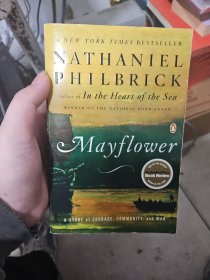
Mayflower: A Story of Courage, Community, and War
¥ 80 7.8折 ¥ 102 八五品
仅1件
山东德州
认证卖家担保交易快速发货售后保障
作者Nathaniel Philbrick 著
出版社Penguin
出版时间2007-04
版次1
装帧平装
货号南屋第八排
上书时间2024-09-09
- 在售商品 暂无
- 平均发货时间 10小时
- 好评率 暂无
- 最新上架
商品详情
- 品相描述:八五品
图书标准信息
- 作者 Nathaniel Philbrick 著
- 出版社 Penguin
- 出版时间 2007-04
- 版次 1
- ISBN 9780143111979
- 定价 102.00元
- 装帧 平装
- 开本 16开
- 纸张 胶版纸
- 页数 480页
- 【内容简介】
-
Book Description
Nathaniel Philbrick became an internationally renowned authorwith his National Book Award– winning In the Heart of the Sea,hailed as “spellbinding” by Time magazine. In Mayflower, Philbrickcasts his spell once again, giving us a fresh and extraordinarilyvivid account of our most sacred national myth: the voyage of theMayflower and the settlement of Plymouth Colony. From theMayflower’s arduous Atlantic crossing to the eruption of KingPhilip’s War between colonists and natives decades later, Philbrickreveals in this electrifying history of the Pilgrims afifty-five-year epic, at once tragic and heroic, that stillresonates with us today.
From Publishers Weekly
In this remarkable effort, National Book Award–winner Philbrick(In the Heart of the Sea) examines the history of Plymouth Colony.In the early 17th century, a small group of devout EnglishChristians fled their villages to escape persecution, going firstto Holland, then making the now infamous 10-week voyage to the NewWorld. Rather than arriving in the summer months as planned, theylanded in November, low on supplies. Luckily, they were met by theWampanoag Indians and their wizened chief, Massasoit. Ineconomical, well-paced prose, Philbrick masterfully recounts thedesperate circumstances of both the settlers and their would-behosts, and how the Wampanoags saved the colony from certaindestruction. Indeed, there was a first Thanksgiving, the authornotes, and for over 50 years the Wampanoags and the Pilgrims livedin peace, becoming increasingly interdependent. But in 1675, 56years after the colonists' landing, Massasoit's heir, Philip,launched a confusing war on the English that, over 14 horrifyingmonths, claimed 5,000 lives, a huge percentage of the colonies'population. Impeccably researched and expertly rendered,Philbrick's account brings the Plymouth Colony and its leaders,including William Bradford, Benjamin Church and the bellicose,dwarfish Miles Standish, vividly to life. More importantly, hebrings into focus a gruesome period in early American history. ForPhilbrick, this is yet another award-worthy story of survival. (May9)
From The Washington Post's Book World/washingtonpost.com
Few periods in American history are as clouded in mythology andromantic fantasy as the Pilgrim settlement of New England. TheMayflower, Plymouth Rock, the first Thanksgiving, Miles Standish,John Alden and Priscilla ("Speak for yourself, John") Mullins --this is the stuff of legend, and we have thrilled to it forgenerations. Among many other things, it is what NathanielPhilbrick calls "a restorative myth of national origins," one thatencourages us in the conviction that we are a nation uniquelyblessed by God and that we have reached a level of righteousnessunattained by any other country.
It is a comforting mythology, but it has little basis in fact.The voyage of the Mayflower was a painful and fatal (one crewmember died) transatlantic passage by people who knew nothing aboutthe sea and had "almost no relevant experience when it came tocarving a settlement out of the American wilderness." Wherever theyfirst set foot on the American continent, it wasn't Plymouth, andit certainly wasn't Plymouth Rock. The first Thanksgiving (in 1621)was indeed attended by Indians as well as Pilgrims, but they didn'tsit at the tidy table depicted in Victorian popular art; they"stood, squatted, or sat on the ground as they clustered aroundoutdoor fires, where the deer and birds turned on wooden spits andwhere pottages -- stews into which varieties of meats andvegetables were thrown -- simmered invitingly." As for PriscillaMullins, John Alden and Miles Standish, that tale is nothing morethan a product of the imagination of Henry WadsworthLongfellow.
These cherished myths, in other words, bear approximately as muchresemblance to reality as does, say, the story of George Washingtonand the cherry tree. In Mayflower, his study of the Pilgrimsettlement, Philbrick dispatches them in a few paragraphs. It takesconsiderably longer, and requires vastly more detail, for him toget closer to the truth about relations between the Pilgrims andthe Indians. Popular mythology tends to focus on Massasoit, thechief of the Pokanokets who allied his tribe with the Englishsettlers, and Squanto, the English-speaking Indian who formed aclose, mutually rewarding friendship with William Bradford,governor of Plymouth Plantation for three decades. Some of whatthat mythology tells us is indeed true, but as Philbrick is atpains to demonstrate, the full truth is vastly morecomplicated.
Philbrick, who lives on Nantucket Island and has written oftenabout the sea and those who sail it -- he won the National BookAward for nonfiction in 2000 for In the Heart of the Sea: TheTragedy of the Whaleship Essex -- specializes in popular history, agenre often sneered at by academic historians but treasured byreaders, who welcome its emphasis on narrative and lucid prose. Heis not as graceful a stylist as the genre's most celebrated livingpractitioner, David McCullough, but his work is entirely accessibleand gives every evidence of being sound scholarship. He appears tobring no bias to his work except a desire to get as close to thetruth as primary and secondary sources allow, in refreshingcontrast to the many academic historians who -- consciously or not-- have permitted political and cultural bias to color theirinterpretations of the past.
Because Philbrick is in search of the more factually complex andmorally ambiguous truth behind essentially self-serving popularmythology, it is important to emphasize that he is not out todenigrate that mythology or those who embrace it. He celebrates thecourage, resourcefulness and determination of many of the settlers,most notably Bradford and the remarkable warrior Benjamin Church;he acknowledges and describes in detail the many ways in whichPilgrims and Indians cooperated, in some cases to their mutualadvantage; he pays particular tribute to Mary Rowlandson, thesettler who was kidnapped by Indians and endured much hardship andprivation but ultimately helped broker peace between Indians andPuritans.
He knows, though, that the story of the Pilgrims can't be reducedto doughty Englishmen and women in modest homespun and smilingIndians proffering peace pipes. Like the settlement of the West,the settlement of New England was hard, bloody and violent. IfIndians made horrendous attacks on settlers -- many of those whomthey killed were women and children -- the Pilgrims more thanresponded in kind. Many of the Pilgrims were pious folk, Puritanswho crossed the ocean in hopes of worshiping as they wished -- they"believed it was necessary to venture back to the absolutebeginning of Christianity, before the church had been corrupted bycenturies of laxity and abuse, to locate divine truth" -- but likethe settlers of Israel three centuries later, they were ready tofight when necessary, and they fought with zeal.
Encouraged by Longfellow and other mythologizers, we have tendedto think of the Pilgrims as earnest, uncomplicated and ratherinnocent, motivated solely by religious faith and goodhearted intheir dealings with New England's native population. There is ameasure of truth to this, in that some settlers wanted to treat theIndians fairly and tried hard to live peacefully beside them, butthey were also fiercely determined to gain a foothold in this newland and did not hesitate to act violently in order to gain one.The famous Mayflower Compact that they wrote and signed during theAtlantic crossing did contain a few of the seeds from which theUnited States and its democratic system eventually sprang, but thesettlers were not especially democratic themselves. They dislikedand suppressed dissent, enslaved Indians and shipped them off tobrutal conditions in the West Indies and clung with such stubbornrigidity to their belief that they alone understood God's will thatthey were incapable of comprehending the Indians' very differentculture.
The early years of Plymouth Plantation were exceedingly difficultbut comparatively peaceful so far as relations with the many Indiantribes were concerned. Gradually, though, as English settlers movedever deeper into New England and as Indians grasped the full extentof the threat to their established way of life, the settlers grewmore belligerent, and the Indians grew more hostile. Indian raidson isolated settlements became more frequent and more brutal. Theburning of Springfield in 1675, in what is now known asMassachusetts (after a tribe that was especially unfriendly to thePuritans), seems to have been the turning point. One prominentsettler said it proved that all Indians were "the children of thedevil, full of all subtlety and malice," a sentiment that manyothers came to share.
The ultimate result was an oddly forgotten chapter in Americanhistory: King Philip's War. Taking its name after the son ofMassasoit who became chief of the Pokanokets, this dreadful littlewar started not long after the raid on Springfield and lasted forabout two years, with gruesome consequences for everyone involved.Plymouth Colony lost eight percent of its male population -- bycomparison, "during the forty-five months of World War II, theUnited States lost just under 1 percent of its adult malepopulation" -- but these losses "appear almost inconsequential whencompared to those of the Indians." The total Indian populationbefore the war was about 20,000; by war's end, "at least 2,000 hadbeen killed in battle or died of their injuries; 3,000 had died ofsickness and starvation, 1,000 had been shipped out of the countryas slaves, while an estimated 2,000 eventually fled to either theIroquois to the west or the Abenakis to the north. Overall, theNative American population of southern New England had sustained aloss of somewhere between 60 and 80 percent."
It was a costly and entirely unnecessary war, brought about byPhilip's vanity, Puritan stubbornness and a pervasive atmosphere ofmistrust and misunderstanding. After the war finally ended, itquickly vanished from the public consciousness except in the placeswhere it was fought: "Thanksgiving and its reassuring image ofIndian-English cooperation became the predominant myth of thePilgrims. . . . In the American popular imagination, the nation'shistory began with the Pilgrims and then leapfrogged more than 150years to Lexington and Concord and the Revolution."
All of which is very much in the American grain. We like ourhistory sanitized and theme-parked and self-congratulatory, notbloody and angry and unflattering. But if Mayflower achieves thewide readership it deserves, perhaps a few Americans will be movedto reconsider all that.
From Booklist
Departing from his customary nautical stories, including thephenomenally popular In the Heart of the Sea (2000), Philbrickmakes landfall with the saga of the Pilgrims. By necessity, allmodern writing about the founding colonists relies on WilliamBradford's Of Plymouth Plantation, interpreting it through modernhistorical sensibilities that incorporate native perspectives onthe newcomers from across the ocean. Long gone is the onceinculcated version of friendly Indians helping starving Englishreligious refugees through hard times. The scholarly thesis now hasthe Pilgrims arriving amid coastal Indian societies that had beendecimated by a pandemic. The Pilgrims appeared in 1620 as apotential ally to the weakened Pokanokets and their sachemMassasoit against neighboring enemies: the Massachusetts and theNarragansetts. Philbrick essentially recounts this reigninginterpretation with sensitivity to landscape description, narrativesuspense, and understanding of motivations: piety, wrath,gratitude, duplicity--a panorama of human character and historicalportent is on display in Philbrick's skillful rendering.Chronologically tracking the fortunes of the alliance struck byMassasoit with Bradford, Philbrick carries events through thesecond generation, in whose collective hands the alliance explodedinto King Philip's War of 1675-76. A sterling synthesis of sources,Philbrick's epic seems poised to become a critical and commercialhit.
Gilbert Taylor
From AudioFile
Author Nathaniel Philbrick strips away the prettiness of what welearned in grade school about the Pilgrims and their religiousbeliefs. We hear accounts of their pulling out the bowels of liveIndians, stealing their food, and taking their possessions. Life inthe New England colonies offered more death and disease thanfreedom at first, and the truthful aspects of the settlers'struggles must be rated "R." George Guidall narrates the gruesomedetails as he tells a cozy story, varying his expression andemphasis to maintain the listener's interest in every sentence.Somehow he knows how to pronounce the hundreds of native names andplaces as if he used the words every day. J.A.H.
From Bookmarks Magazine
Mayflower rethinks the events and players that gave rise to anational mythology about Pilgrims living harmoniously with theirIndian neighbors. Instead, Philbrick tells a story of ethniccleansing, bloody wars, environmental ruin, and the deteriorationof English-Indian relations. While he introduces familiar elements,Philbrick also recasts well-known characters like Miles Standish("Captain Shrimp"), William Bradford, and Benjamin Church. Mostcritics agree that he provides a well-researched, unbiasedrevisionist history (though we should note that for years manypeople have been reading about the environmental devastation of NewEngland, the bloody Indian-English wars, and the less-than-piousPilgrims). If not as gripping as the National Book Award?winning Inthe Heart of the Sea (2000), particularly the second half,Mayflower nonetheless provides a harrowing account of survival and,despite its grim themes, a celebration of courage.
Book Dimension
length: (cm)19.7 width:(cm)12.8 - 【作者简介】
- Nathaniel Philbrick is the author of the New York Timesbestseller In the Heart of the Sea, which won the National BookAward, and Sea of Glory, winner of the Theodore and Franklin D.Roosevelt Naval History Prize.
点击展开
点击收起
— 没有更多了 —
















以下为对购买帮助不大的评价